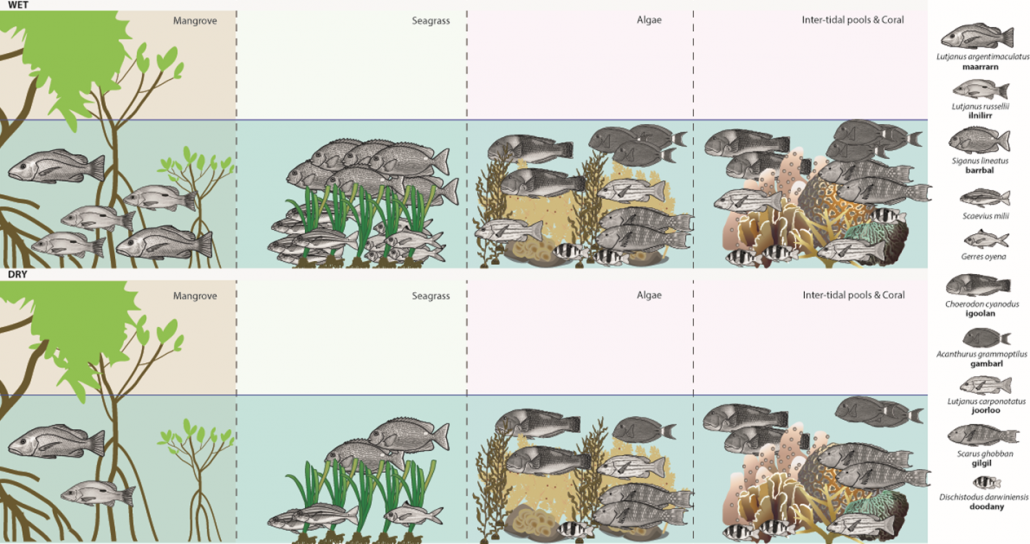Scientists Examine Ways to Return Knowledge to Country
Returning science knowledge to Traditional Owners on Country has been identified as an important consideration for researchers working in all regions of Australia.
In a recent review of the Western Australian Marine Science Institution’s Kimberley Indigenous Saltwater Science Project processes and protocols for working on Country, WAMSI Science Coordinator Dr Kelly Waples from the Department of Biodiversity Conservation and Attractions (DBCA) found improving communication was a strong theme raised by the Indigenous saltwater groups, Healthy Country Managers and scientists, particularly during the initial introduction, project proposal and the return of information to the community stages.
“Much of the feedback from our survey interviews revolved around developing some communication tools and examples of good communication to assist researchers in not only delivering their results back to the community, but also to include Indigenous perspectives and cultural insights to make them more relevant to the Traditional Owners,” Dr Waples said.
In 2019 WAMSI Research Director Dr Jenny Shaw began the process of developing a science plan for Gathaagudu (Shark Bay), the traditional country of three Aboriginal language groups: Malgana, Nhanda and Yingkarta.
It quickly became apparent that the traditional custodians of Gathaagudu had little knowledge of the large amount of science that had been conducted in the region since 1954, and it was something they wanted to understand.
“Generations of Malgana people attended a three-day workshop where we presented them with large-scale maps, graphs and illustrations that represented the work from more than 700 publications,” Dr Shaw said. “It was quite an emotional realisation I think, that so much research had been done without their knowledge.”
Researchers from the Australian Institute of Marine Science (AIMS), led by Dr Katherine Cure, have also sought to address a call from senior Indigenous leaders and rangers to communicate the findings from their sea country monitoring program in a way that is accessible to all generations and diverse levels of numeracy and literacy.
In 2020/2021 the AIMS scientists visited the Bardi Jawi community at One Arm Point in the state’s North West, where they have established a long-term monitoring program with the Bardi Jawi Rangers. Using results from the monitoring program, the researchers trialled six different communication products during a-week-long workshop in various settings and with several audiences including school students, Elders and the wider community.
The pros and cons for Story Maps (ArcGIS), report cards, PowerPoint presentations, videos, posters and an environmental science art workshop with AIMS Artist-in-Residence Angela Rossen were all discussed.
Dr Cure says, among the lessons learned, large printed maps with graphical representations of research results presented to small groups for focused interactions worked well. Also, while online ArcGIS Story Maps were more dynamic and visually attractive than PowerPoint presentations, they rely on internet connection; since download speeds in most remote communities is an issue, this needs to be considered.
“We managed to share results of three years of monitoring in several formats with school children, rangers and Elders, and gained some valuable insights,” Dr. Cure said. “We found that while the Rangers can deal with more complex science outputs than Elders or children, it is important to know your audience and discuss reporting outputs and formats with partners in advance. Also, we found that a diverse range of communication materials are needed, including printed maps, graphs, infographics and videos.”
Identifying and referring to species in local language and relating results back to Healthy Country Management plans where possible has also been identified as an important consideration for scientists.
The full summary of the AIMS investigation into sharing monitoring results across generations of Traditional Owners on Sea country can be found here:
CLOSING THE CIRCLE Sharing monitoring results across generations of Traditional Owners in Sea Country_ Graphical Summary_ Cure et al. AIMS
COMMUNICATION EXAMPLES
- Towards Closing the Circle _Communication Examples_ CURE et al. AIMS
- Excerpt of presentation materials prepared for return of knowledge to the Malgana peoples of Gathaagudu_Shark Bay_2021 Shaw et. al. WAMSI
POWERPOINT PRESENTATIONS
INFOGRAPHICS

Above: WAMSI Recruitment and Herbivory infographic of findings for juvenille fish RUV: Different types of fish live in different habitats during different seasons. (Cure et. al.)
POSTERS
- Jigeedany (dolphin) survey A1 Poster DBCA/Dambimangari
- Common Marine Life of the Bonaparte_ Richards_WAMSI/WAM
- Turtle Poster 1 – DBCA
- Turtle Poster 2 – DBCA
- Turtle Poster 3 – DBCA
- Shellington A3 info Poster DBCA
BOOKLET
Jigeedany (dolphin) survey DBCA_Dambimangari_Booklet
STORY MAPS
- Corals are changing on some Northern GBR reefs– AIMS
- Seagrass Extent Change in Shark bay (Gathaagudu) – AIMS
- Acting now can buy us time on climate change – ABC
VIDEOS
- Bardi Jawi IPA Coordinator Daniel Oades & Ranger Azton Howard intro the Gaarragoon Guardians video
- Gaarragoon Guardians – Bardi Jawi Rangers
- Sharing Marine Monitoring in Bardi Jawi Sea Country
- Mapping Makarda: working with the Land and Sea Rangers of Groote Eylandt
- Ranger Workshop – March 2017
EDUCATION RESOURCES
Data Science STEM resources in collaboration with Education Services Australia
GRAPHICS
RELATED LINKS
- Kimberley Indigenous Saltwater Science Guide for Researchers – WAMSI
- AIMS Indigenous Partnerships – AIMS
- Indigenous Knowledge – North West Atlas/AIMS
- Our Knowledge Our Way Guidelines – CSIRO
- Sea country research: exploring successes and challenges in Indigenous engagement – NESP
- Guidelines for ethical and effective communication for researchers working in Torres Strait – CRC Torres Strait
- Guidelines for ethical and effective communication for researchers working in Torres Strait – Jones and Barnett
- AIATSIS Code of Ethics for Aboriginal and Torres Strait Islander Research – AIATSIS

